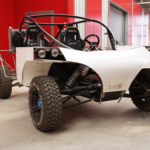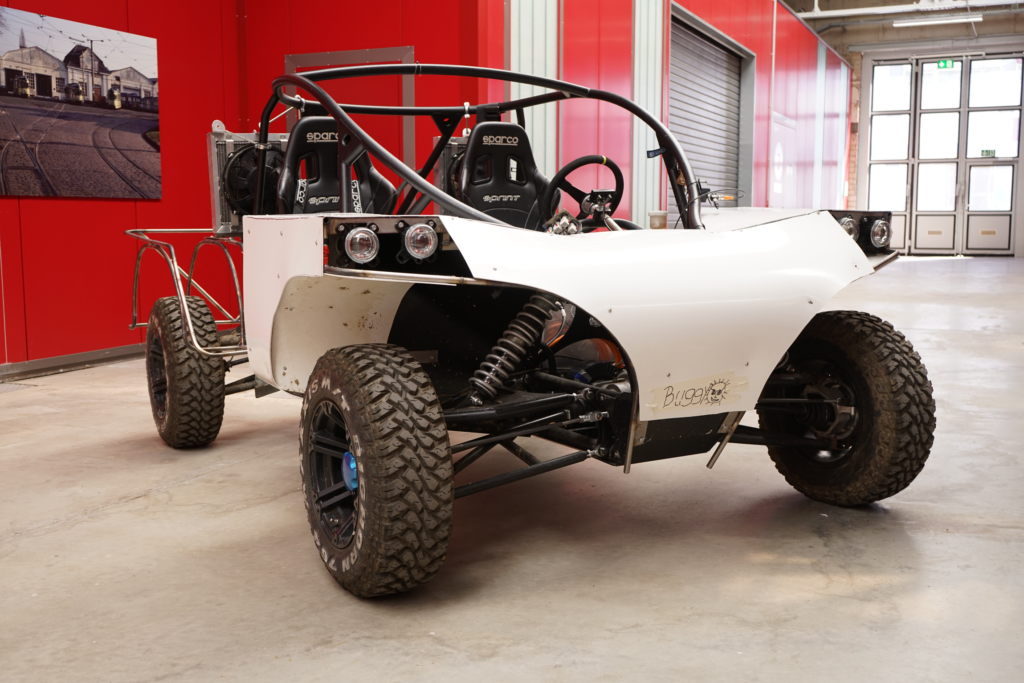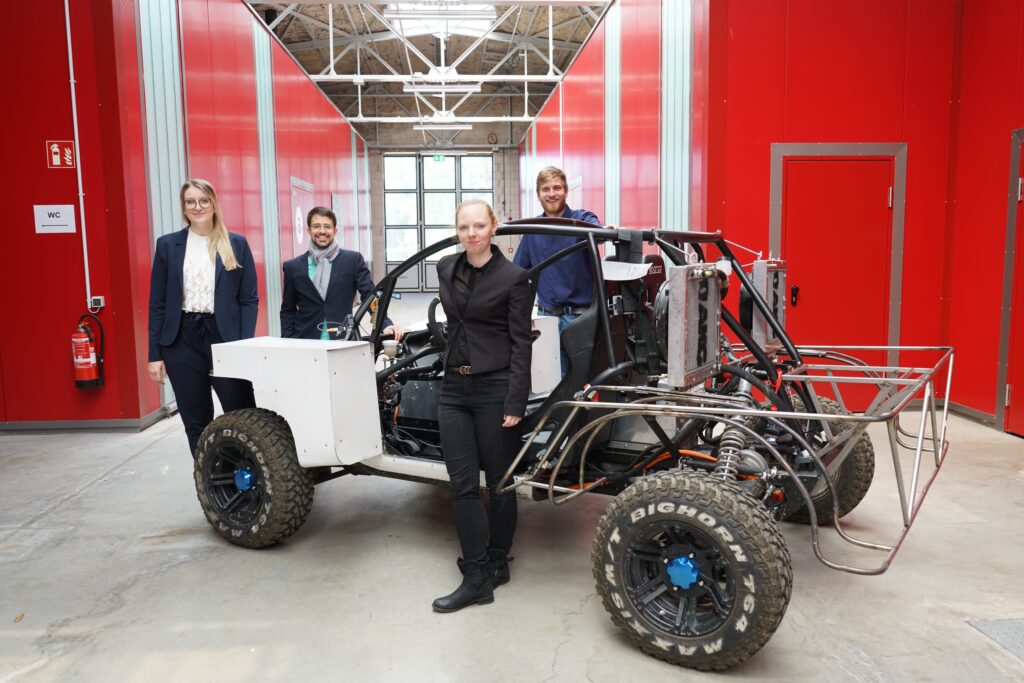The German SolarBuggy – on a mission to set a world record



What will the interior of cars look like in a few decades? And what about the future of mobility? The question of mobility will definitely never let go of us. Nobody who deals with cars today can ignore hybrid vehicles, cars with fuel cells or high-voltage batteries. There is also a very fascinating answer to the question of how to make mobility environmentally friendly. The inventors of the SolarBuggy, a German team of students, developed a vehicle with the unique technology of foldable solar modules that enable self-sufficient mobility. We have gathered here everything from the idea to the ambitious world record plans of the makers.

An extremely smart group of budding engineers from Bochum University of Applied Sciences, the Bochum University of Applied Sciences, also sees the fact that there is a lot of potential in the area of alternative vehicle propulsion in particular and that a lot is currently undergoing change. Solar vehicles have been developed here for 18 years. The declared goal is to build vehicles that draw their energy from the sun and not from polluting fossil fuels. The priority is to demonstrate the potential of solar energy not only for stationary but also for mobile applications.
The student team was formed in 2013 from the university's SolarCar project. Since then, the most innovative ideas have sprouted from the project and make solar energy more and more interesting in this respect - not least because solar cells are constantly being further developed and thus more effective. With "Open World", their first SolarBuggy, they already covered a distance of 829 kilometres over the Australian Tanami Road in 2015. This outback track connects the Stuart Highway near Bond Springs north of Alice Springs with the Great Northern Highway southwest of Halls Creek.
When the students converted a petrol-powered beach buggy into a SolarBuggy, they landed a sensational coup with the next generation. Sensational with good reason due to its special technical features. Thanks to a unique solar cell system, this e-mobile now covers its distances completely independently of the grid. In the constellation of currently 23 clever minds, they developed the electric off-road solar buggy, which makes it possible to cross a sandy desert only with solar energy. Its heart is a unique, innovative application of foldable solar collectors. In this order of magnitude, such constructions have so far only been used in space.
The folding construction was conceived on the model of an origami construction by the Japanese astrophysicist Koryo Miura. The Miura folding technique divides a paper into a net of rhomboids. If one pulls on two opposite sides, it can be pulled together and apart again with a handle. Material folded in this way can be brought into a wide variety of shapes. This technique is not only used by NASA space researchers, but also by Bochum students for their solar arrays. It consists of four foldable modules made of monocrystalline silicon, is 40 square meters in size, of which the effective area is 27 square meters and has an output of 6 kilowatts. With the help of the solar array it carries, the SolarBuggy can charge its 400V lithium-ion battery quite simply through the sun itself. In other words, it charges completely solar self-sufficiently in three hours, i.e. without being connected to the grid.
Of course, you have to show what an offroad buggy can do now and then, apart from offering a lot of driving fun while cruising around in the country. In addition to the wind that blows directly and wonderfully authentically around your nose when you master the off-road test tracks, the ingenious feel of an electric vehicle does the rest: When you press the accelerator pedal, the SolarBuggy accelerates immediately because the full torque of an electric motor is immediately available. The 120 km/h fast E-Flitzer with its 15 kWh battery has a range of 150 kilometres per battery charge. Two synchronous motors with a rated power of 20-32 kW and a peak power of 80 kW generate a torque of 150 Nm (max) and 80 Nm respectively.
The SolarBuggy is to cross the Simpson Desert in Australia for the first time. About 1,100 light brown to deep red, sometimes gigantically high sand dunes make this trip an adventurous wilderness trip for every four wheeler. The French Line Track is the most difficult route through this desert. The Simpson Desert is the largest parallel sand dune semi desert system in the world. In 2017, an Australian team with an all-wheel drive Suzuki converted from a combustion engine to a solar powered electric motor managed to cross the desert in 4 days, 21 hours and 23 minutes. This has to be topped.
Respect for this trip is called for: It is recommended to face the French Line with a lot of desert experience and good equipment. But the students don't lack ideas here either: They cleverly got help from someone with a lot of desert experience. The former Dakar Rally winner Eric Vigouroux provided the team with the idea of the basic structure for the buggy. In this, currently the second project cycle, they are working on the larger and completely self-built SolarBuggy called "Froggee". It owes its name to its frog-like exterior. To ensure that the buggy is perfectly suited for the desert, the mechanics are currently producing the bodywork. The materials used include steel pipes and ABS plastic sheets.
In October of this year the great journey is on the agenda. When the students of the SolarBuggy team try to set the world record in the Australian desert with the first solar vehicle made by the students themselves, we will of course keep our community up to date on our VadoTech Facebook page about the SolarBuggy's attempt to set a world record and report on the potential of renewable energies in the automotive sector as well.
We, who are on the road worldwide day after day with passion in our job vehicle testing, of course always want to be directly involved, of course. It's good that we have the opportunity here to talk to the developers about their vision in detail.
We are a student project that tackles problems that would otherwise not be tackled. We take a system which is developed in the city or can be used everywhere. With the mobile solar system of our SolarBuggy cars can be charged everywhere. So the vehicle is completely self-sufficient. This approach has not yet been adopted by large companies, as they usually think in urban terms. But we think: cars are mostly used outside the city. In our opinion, the charging infrastructure as it is thought at the moment does not work. The charging infrastructure is missing. Maybe Europe- or Germany-wide yes, but if you come to Africa or to very remote areas where there is not even electricity, it stops already. Then why should there be a charging station there? Sure.
The electricity is 100% green - it is pure solar energy! And so we can claim: Local emission-free driving is completely bypassed. Because we say: You are emission-free everywhere. In our opinion, this functionality is infinitely expandable, depending on space and goal.
No, as students we have already started this completely on our own. It runs under the name of the university, but we students finance and plan it completely on our own. The students of the Institute for Electromobility have already gone through several generations of the solar car project. This is unique in Germany: The work in the project is organized in the form of Problem Based Learning (PBL). Students are gradually given more and more responsibility for building their own knowledge, and real problems and corresponding solutions are developed in teams and across disciplines. The team leadership as well as all team members are students.
Every two years, newly developed, highly efficient, electrically powered solar vehicles are developed that want to compete with the competition. This will enable you to acquire technological expert knowledge in the field of electric drive and vehicle technology! Which degree courses do you take - and: Why are you doing this?
Why do we do this? We want to apply our knowledge not only theoretically, but also practically. We study mechatronics, mechanical engineering, electrical engineering, industrial engineering or sustainable development. This is possible from the 1st to the 10th semester, regardless of whether you are studying for a Bachelor's or Master's degree. It depends on what previous knowledge you have. But in principle, everyone can help.
Yes, but only for some degree programmes as project work. The building itself does not count as a module for the study itself.
Yeah, some of us go waitressing, others work in battery development. A project manager gets paid 20 hours a month. Depending on the person, everything is included from 2 to 40 hours per week. Of course, there is more during the semester break than during the exam phase, of course.
First and foremost: Not everyone has to be able to do everything! The knowledge of individuals is combined into an overall concept. However, some of you also find out from this experience: I don't want to do later what I have to do here with many in the team. After all, I am a developer and not a kindergarten teacher.
There are very different motivators: to create a world record. Or to construct the vehicle itself. The innovation of the solar shop. To further develop the knowledge for oneself. To do something real, to build something, because the study is too theoretical. The whole thing is a learning project. Nobody knew how to start a project. Just take the topic of sponsoring: When do you have to do something? What is the best way to present yourself? Which companies or sponsors are the most interesting for us? The more people learned together here, the better the project was structured. It's a super exciting process.
Yes, that's a funny story: Thierry Wilmes, managing director of AUKTORA, wanted to drive a diesel vehicle through the desert. Then all of a sudden he noticed: Hey, a solar buggy would have made much more sense here than anything else! Basically the project was born out of it.
Yes, but only to a very small extent compared to the total costs. The university admits the SolarBuggy project, but is not the sponsor itself.
Yes, all seven companies have already emerged from the projects! For example, the aforementioned AUKTORA, an independent engineering service provider for agile product development in the field of electric drive and vehicle technology. Or Voltavision, a development and test centre for power electronics and energy storage that develops solutions for everyday electric mobility and the use of renewable energies.
We write to them and beg them; some of the companies give free support and are also very interested in the results. But many companies just want the name on the car. Other companies also use the buggy as a test object. Often there are companies that are very interested and approach us, but unfortunately we have to find out that the product does not suit us.
In most cases this happens together! Even people who have no technical knowledge often have the right ideas. They are all untested systems that cause problems.
Thank you for your time, which we curious nerds were allowed to get rid of from the vehicle testing on you. The future belongs to electric mobility in its various facets! Electromobility is becoming increasingly important for the energy revolution in the vehicle market. We remember: The German government alone had once set the goal of achieving a stock of one million electric vehicles in the German vehicle fleet by 2020.

The automotive industry is therefore in the midst of a radical change that needs clever innovations. Sooner or later, the formerly classic division of the new vehicle market into gasoline and diesel vehicles will give way to a portfolio of different, electrified drives. The technologies of electrified vehicle concepts mean that electric drives and high-voltage batteries can be used to drive a large number of electrotechnical components into the vehicle.
Of course, this also poses many challenges for the integration of high-voltage systems into vehicles. Not just for the development engineers, but for everyone involved in the business. As the innovative electric cars are operated at high voltage, special protective measures are required. If you, as an interested reader, also have to master all these topics, we recommend that you complete a high-voltage training course. In the VadoTech high-voltage training course you will learn how to safely interrupt the power supply in electric vehicles, how to handle the hazard potential safely and competently and how to avoid any accidents of this kind. Here you can find out more about the various stages of high-voltage training.
We’re here to help! You can reach out to us by phone at +49 30 327 644 13 or email us at training@vadotech.com. Our team is happy to assist you with any questions.
Get in touch
"*" indicates required fields
You need to load content from reCAPTCHA to submit the form. Please note that doing so will share data with third-party providers.
More Information